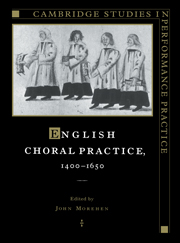Book contents
- Frontmatter
- Contents
- List of plates
- General preface
- Preface
- Abbreviations
- 1 To chorus from quartet: the performing resource for English church polyphony, c. 1390–1559
- 2 Editing and performing musica speculativa
- 3 The sound of Latin in England before and after the Reformation
- 4 English pronunciation, c. 1500 – c. 1625
- 5 Byrd, Tallis and Ferrabosco
- 6 John Baldwin and changing concepts of text underlay
- 7 Sacred songs in the chamber
- 8 The education of choristers in England during the sixteenth century
- 9 The ‘burden of proof’: the editor as detective
- Index of names and places
- Index of manuscript and printed music sources
- Index of works cited
6 - John Baldwin and changing concepts of text underlay
Published online by Cambridge University Press: 03 March 2010
- Frontmatter
- Contents
- List of plates
- General preface
- Preface
- Abbreviations
- 1 To chorus from quartet: the performing resource for English church polyphony, c. 1390–1559
- 2 Editing and performing musica speculativa
- 3 The sound of Latin in England before and after the Reformation
- 4 English pronunciation, c. 1500 – c. 1625
- 5 Byrd, Tallis and Ferrabosco
- 6 John Baldwin and changing concepts of text underlay
- 7 Sacred songs in the chamber
- 8 The education of choristers in England during the sixteenth century
- 9 The ‘burden of proof’: the editor as detective
- Index of names and places
- Index of manuscript and printed music sources
- Index of works cited
Summary
An important consequence of the dissemination of humanist ideas among continental theorists and musicians at the beginning of the sixteenth century was the emergence of an intense concern with language and a recognition of the primacy of the text. This new word-consciousness manifested itself in the efforts of composers to adapt their rhythms to the accentual properties of speech and to pattern musical phrases according to textual syntax. Improvements in declamation were also advocated with a view to ensuring the comprehensibility of the words, and composers – aware of the advantages of syllabic over melismatic writing as a means of achieving this end – gradually abandoned the florid style in favour of a more word-dominated approach to composition. This change of attitude had a profound effect not only on the new music that was being written but also on a large body of older polyphony, of which the melismata were retrospectively subjected to a process of syllabification by later editors and scribes. In this connection Hans Albrecht has noted the increased use in continental sources of signs for textual repeats, the so-called ditto- (or iterum- or idem-) signs, by means of which ‘it was possible to set long melodies, originally sung, one might assume, to one syllable, in a straightforward or fairly straightforward syllabic style’. From a comparison of individual works as they appear in earlier and later sources – the earlier sources without ditto-signs, the later ones with them – Albrecht concludes that ‘older pieces in later copies have their text more precisely aligned and, with the help especially of text repeats, more densely set’.
- Type
- Chapter
- Information
- English Choral Practice, 1400–1650 , pp. 143 - 160Publisher: Cambridge University PressPrint publication year: 1996
- 1
- Cited by



